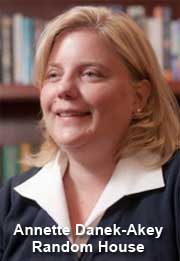From SCDigest's On-Target E-Magazine
- May 14, 2013 -
Supply Chain News: Theory of Constraints Working in Random House Distribution Center, as Publisher Uses Dynamic Buffer Management
Emergency Replenishments in Active Pick Areas Plunge; Changed DC Focus from Cost to Sales Growth - with Big Results
SCDigest Editorial Staff
In general, it has been tough to adapt traditionally more manufacturing-oriented concepts such as Lean and especially Theory of Constraints (TOC) to distribution operations.
We've published a few pieces on successes in this area before, such as Intel's use of TOC in its DC operations (see Using Theory of Constraints to Improve Distribution Throughput at Intel.) TOC, as most know, is the technique developed by the late Dr. Eli Goldratt and popularized in his business novel "The Goal" in 1984 and then later works.
SCDigest Says: |
 |
| The system was developed internally by Random House and integrated with its WMS. Few if any WMS solutions even from tier 1 providers have such a capability today. |
|
What Do You Say?
|
|
|
|
Intel used TOC to identify its packing operation as the main constraint, and then used the packing area as the "drum" that drove upstream picking activity.
Now, a new, interesting and different success story on the use of TOC in distribution from book publisher Random House, which presented at the recent Warehouse Education and Research Council annual conference in Dallas.
The problem, according to Annette Danek-Akey, senior vice president of fulfillment for Random House, was in the nature of the book publishing business. Forecast accuracy is not good. Most book stores only have one copy of a given title on the shelf at a time, so when that copy is sold, the store is out of stock until the book is replenished by Random House. Since book sellers only ordered once a week, that meant there would often be a number of days or even two weeks with the title not available for sale. The level of returns was very high and costly.
Several years back, Random House like most companies was primarily focused on costs in its logistics operation, with fulfillment cost per unit being the primary metric. But was that right? Would the company in total be better off if it turned its primary mission to growing company sales and total profit instead?
That in fact is the path Random House eventually took, with dramatic implications. It did so with the help of Dr. Goldratt himself, and it turns out the Goldratt's last business novel, "Isn't it Obvious," was based on his experience with Random House.
Danek-Akey offered some lessons learned on the people and process side of Random House's transformation, an area where Goldratt always placed a lot of his focus. Those included:
 People are Inherently Good: Too often, we view people fighting change as bad people, when it is usually that those people are operating under bad assumptions. Managers/execs need to work to understand those assumptions, and recognize that often if not most of time some of the fears an employee has are in fact legitimate. You need to lay out the positives and negatives both for change and non-change to start to break down resistance. People are Inherently Good: Too often, we view people fighting change as bad people, when it is usually that those people are operating under bad assumptions. Managers/execs need to work to understand those assumptions, and recognize that often if not most of time some of the fears an employee has are in fact legitimate. You need to lay out the positives and negatives both for change and non-change to start to break down resistance.
Any Constraint can be Overcome - and it Might be You: Danek-Akey said that since at one level Random House appeared to have a well-performing logistics operation (it also provides third-party fulfillment services to more than 30 other publishers) she herself may have been the top barrier to rethinking goals and operations. Many other supply chain executives may be in the same situation, if they assess the themselves with total honesty. She said it is also importance to understand the difference between control and influence - the latter of which can have a much broader scope.
Recognize that How Someone is Measured is How they Will Behave: Are metrics truly aligned with the real goals of the company? Thinking through this principle is in part what led to a change in focus at Random House from logistics costs to sales growth.
(Distribution/Materials Handling Story Continues Below
)
|
Every Complex Problem can be Shown to be Exceedingly Simple in the End: This is really one of the core concepts of TOC, and involves accurately identifying the current constraint.
Always Look for Win-Win: Another principle that Goldratt frequently preached, working to find that true win-win solution (which Goldratt insisted was always possible) obviously breaks down the barriers to change.
In the end, Random House recognized that faster, more reliable fulfillment was the key to driving sales growth through better in-stock positions at the shelf and lower retail inventories, making Random House a preferred supplier. And to get there, it in part needed to redefine its replenishment times, which previously had been viewed only from view of the DC: how long did it take to pick, pack and ship upon receiving an order?
But that cycle usually took no longer than three days, often less. The real bottleneck was the once per week order cycle at the retailer. What if retailers ordered every day instead, taking many days off the total replenishment cycle?
The fear of such a move, of course, was that in the end this change would negatively impact the all-important cost per unit metric. But when viewed from a sales growth perspective, Random House believed small increases in costs would pay big dividends in revenue. As it turned out, the sales growth was achieved big time, while the cost increases predicted was less than expected.
Sales at retailer Target, for example, are now up some 70% from when the new program started.
Dynamic Buffer Management
Capacity and inventory buffers are key levers in TOC thinking, and while the big breakthrough for Random House came from the new ordering cycles, the company wanted to reduce that time for pick, pack and ship as well to further reduce total replenishment times.
The constraint there, said Alison Martin, vice president of fulfillment operations and IT systems at Random House, was in replenishing active pick areas from reserve. Those active pick locations acted as the buffer against demand.
Like most companies, Random House operated on a simple min-max system. When inventory in a pick location reached some threshold (e.g., 35% of capacity), a replenishment task would be generated. Products were slotted in the different storage modes in active (carton flow, large rack locations, small rack locations) in typical ABC volume fashion.
 Such a system, by definition, is static, applying the same rules all the time regardless of actual demand. It also means a slot is often replenished even when there is little demand for that SKU. Such a system, by definition, is static, applying the same rules all the time regardless of actual demand. It also means a slot is often replenished even when there is little demand for that SKU.
Conversely, it can also mean that a given wave of work wipes out the inventory in that location, especially if it is near but not at its threshold level.
In fact, "emergency replens," defined as when the volume in a wave for a given SKU exceeds the number of units in the pick slot, represented some 38% of total replenishment activity at Random House. In the end, that led to delays picking and shipping orders.
Using TOC principles, Random House rethought this whole paradigm and moved to a dynamic approach to slotting and replenishment. Key to that was capturing each SKU's location and inventory levels and demand for that SKU every day. (Martin told SCDigest after the presentation that Random House also then nets out actual replenishments that occurred in a day to keep the numbers consistent across all SKUs, replenished or not).
That data, which very few distribution centers capture today (no one in the audience was capturing this data daily) can then provide analytics into which SKUs are frequently requiring emergency replens, which SKUs seem to have too much inventory, and which are about right.
This then results in dynamically changing the buffer inventory targets and the slotting location for each SKU. The goal is to be in-stock in the active area for every SKU all the time, but smartly, by not over-replenishing SKUs that are on a good in-stock position versus demand.
The system was developed internally by Random House and integrated with its WMS. Few if any WMS solutions even from tier 1 providers have such a capability today.
The result is that the number of emergency replens have dropped from the 38% level mentioned above to just 1.7%. The strategy has taken almost one full day out of average pick, pack and ship times, and the total program has reduced returns by about 30%, by filling orders more closely tied to actual consumer demand , so retailers might order just one book rather than three and later return two of them.
The changes occurring at Random House (a division of Germany's Bertelsmann) aren't just in the distribution center, Danek-Akey said. Compensation is being aligned to business success across the company, so much so that after a recent good year, all the associates in the DC received bonus checks for some $5000.00.
That, SCDigest guesses, would get them focused on customer service and sales growth very quickly.
What is you reaction to this approach by Random House? Could more companies benefit from changing to a growth focus rather than costs? What is your take on the dynamic buffer management approach? Anyone doing something similar? Let us know your thoughts at the Feedback button below.
 |